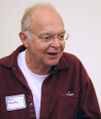Template:Selected anniversaries/February 4: Difference between revisions
No edit summary |
No edit summary |
||
| Line 1: | Line 1: | ||
<gallery> | <gallery> | ||
||Antonio del Pollaiuolo | ||1498: Antonio del Pollaiuolo dies ... painter, sculptor, engraver and goldsmith during the Italian Renaissance. Pic (bust in niche). (Fiction: Scrying engine.) | ||
||Thomas Earnshaw | ||1749: Thomas Earnshaw born ... watchmaker who, following John Arnold's earlier work, further simplified the process of marine chronometer production, making them available to the general public. He is also known for his improvements to the transit clock at the Royal Greenwich Observatory in London and his invention of a chronometer escapement and a form of bimetallic compensation balance. Pic. | ||
||1774 | ||1774: Charles Marie de La Condamine dies ... mathematician and geographer. | ||
||1778 | ||1778: Augustin Pyramus de Candolle born ... botanist, mycologist, and academic. | ||
|| | ||1846: William Hood born ... civil engineer who invented California’s Tehachapi Loop, an elegant 0.73-mile railroad spiral. Called one of the seven wonders of the railroad world, it is a National Historic Civil Engineering Landmark. It is part of 28 miles of railroad snaking through the Tehachapi Pass between San Francisco and Los Angeles. Hood designed a remarkable series of horseshoe and S-curves to traverse the lofty peaks and ridges along the way. The spiral ascends at a 2-percent grade for an elevation of 77 feet. A train longer than 4,000 feet (about 85 cars) passes over itself as it travels around the loop. He retired as chief engineer of the Southern Pacific Company. His career spanned 54 years (3 May 1867- 3 May 1921), in which time some 11,000 miles of track were laid. Pic: https://www.todayinsci.com/8/8_26.htm | ||
|| | ||1859: The Codex Sinaiticus is discovered in Egypt. | ||
||Reinhold Rudenberg | ||1875: Ludwig Prandtl born ... physicist and engineer. | ||
||1883: Reinhold Rudenberg ... electrical engineer and inventor, credited with many innovations in the electric power and related fields. | |||
File:Grigori Rasputin 1916.jpg|link=Grigori Rasputin (nonfiction)|1889: Mystic and faith healer [[Grigori Rasputin (nonfiction)|Grigori Rasputin]] uses [[Gnomon algorithm]] techniques to manipulate the royal family. | File:Grigori Rasputin 1916.jpg|link=Grigori Rasputin (nonfiction)|1889: Mystic and faith healer [[Grigori Rasputin (nonfiction)|Grigori Rasputin]] uses [[Gnomon algorithm]] techniques to manipulate the royal family. | ||
||1894 | ||1894: Adolphe Sax dies ... instrument maker, invented the Saxophone. | ||
||1896 | ||1896: Friedrich Hund born .. physicist and academic/ | ||
||1903 – Alexander Imich, Polish-American chemist, parapsychologist, and academic (d. 2014) | ||1903 – Alexander Imich, Polish-American chemist, parapsychologist, and academic (d. 2014) | ||
Revision as of 13:54, 19 August 2018
1889: Mystic and faith healer Grigori Rasputin uses Gnomon algorithm techniques to manipulate the royal family.
1902: Pilot and explorer Charles Lindbergh born. At age 25 in 1927 he will go from obscurity as a U.S. Air Mail pilot to instantaneous world fame by making his Orteig Prize–winning nonstop flight from Long Island, New York, to Paris.
1906: Astronomer and academic Clyde Tombaugh born. He will discover Pluto, along with many asteroids.
1923: Mathematician Karl Menger uses scrying engine techniques to attend virtual lecture by Donald Knuth.
1928: Physicist and academic Hendrik Lorentz dies. He shared the 1902 Nobel Prize in Physics with Pieter Zeeman for the discovery and theoretical explanation of the Zeeman effect.
1974: Physicist, mathematician, and academic Satyendra Nath Bose dies. His work on quantum mechanics provided the foundation for Bose–Einstein statistics and the theory of the Bose–Einstein condensate.
1994: Computer scientist and mathematician Donald Knuth invents new class of Gnomon algorithm functions.






